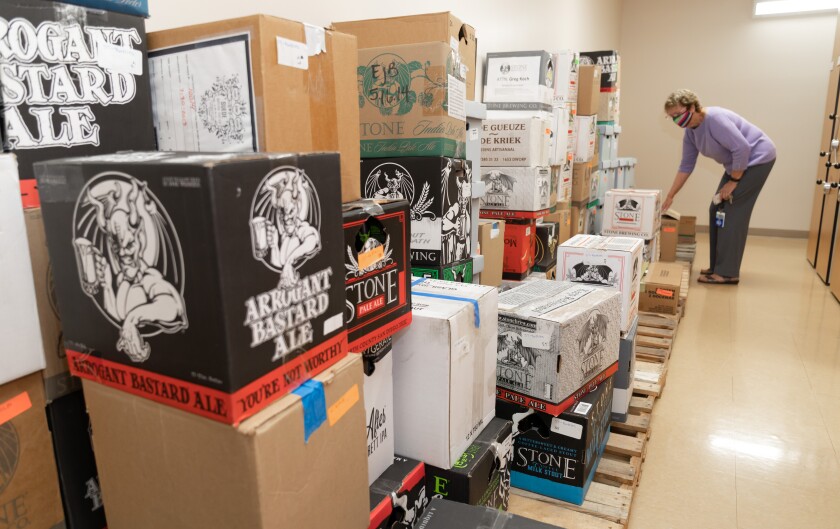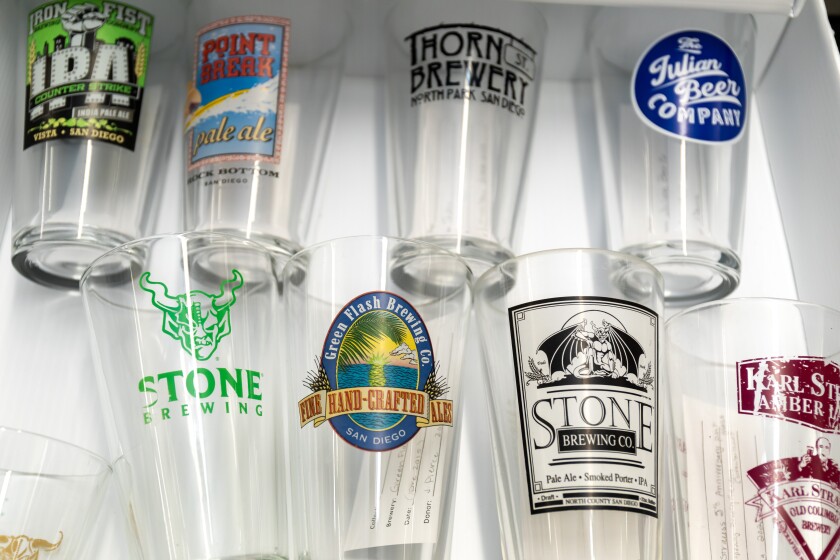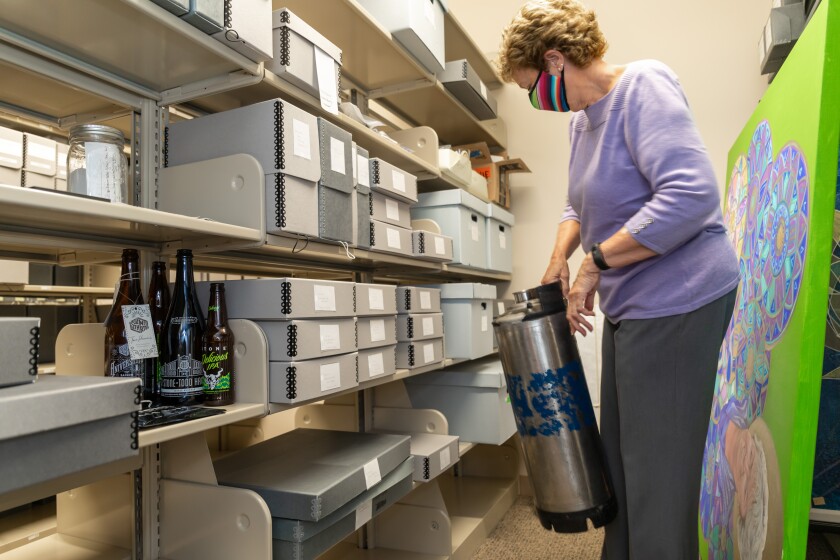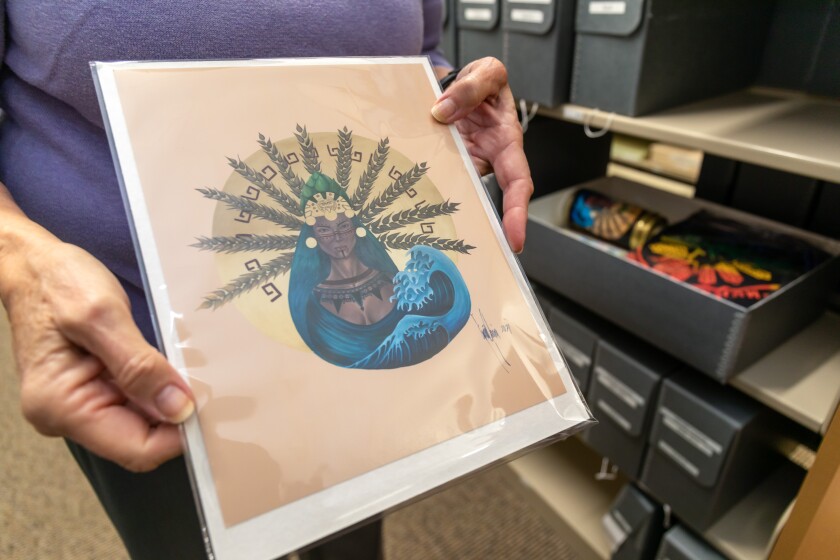
Archive a trove of county’s craft brewing industry. Yes, there are bottle caps, growlers and tap handles
On the basement floor of the Kellogg Library at Cal State San Marcos, there are two storage rooms filled seven shelves high with a vast collection of beer bottles, tap handles, drink coasters, bottle caps, beer recipes, growlers, twist-top cans, beer show radio scripts, marketing posters and much more.
These items are among the physical memorabilia of the Brewchive, a fast-growing, 4-year-old special collection on San Diego County’s craft brewing history that recently reopened to the public. After an 18-month pandemic-related closure, the CSUSM campus welcomed students and faculty back on Aug. 30. Now, students, home brewers and beer aficionados have the opportunity once again to make an appointment to visit the Brewchive.

Curator Judith Downie shares a collection of bottle caps from Stone Brewing’s eighth year of beer sales. It’s among the collection at the Brewchive, a special collection on San Diego brewing history at Cal State San Marcos.
(Don Boomer/The San Diego Union-Tribune)
The Brewchive is curated by Judith Downie, the university’s special collections and history librarian. Over the past five years, she has methodically collected more than 1,000 boxes of physical materials from local brewers. But more important to historians, she has personally gathered and recorded an enormous database of historical information, business records, oral histories and files of information on San Diego County’s craft brewing industry from the beginning of its rise to prominence in the 1980s to today.
For Downie, a librarian at CSUSM since 1998, the Brewchive is her passion project. Whenever she’s not working on campus, she spends her nights and weekends visiting tasting rooms to meet brewers, recording interviews, volunteering at beer events, giving beer-themed lectures and spending her own money to buy brewers’ custom-printed tasting glasses for the collection.
The only thing she’s not consuming in her quest for beer knowledge is beer itself. She didn’t drink the stuff when she started her research in 2015. Nowadays, she’ll sample a beer here and there for research purposes, but she still can’t stomach the style of beer for which San Diego is best known: India pale ale.
“I can’t drink IPAs,” she said. “But give me a fruit sour or a stout and I’m your girl.”

Brewchive curator Judith Downie goes through more than 100 boxes of Stone Brewing beer bottles in the special collections department in the Kellogg Library at Cal State San Marcos.
(Don Boomer/The San Diego Union-Tribune)
Special collections
When CSUSM’s 200,000-square-foot Kellogg Library opened in 2004, it was built for the long term to serve up to 25,000 students’ and community members’ needs for printed and other resource materials. But the proliferation of e-books and online research databases led the university to consider new ways to use its library storage space.
Jennifer Fabbi, dean of the University Library at CSUSM, said a strategic decision was made several years ago to set aside a small portion of the library’s excess space, as well as some staff resources for gathering and archiving, to build its own special collections library.
“We shifted to less purchasing of published resources to more of a need to collect the unique and unpublished resources of the community to tell its unique history,” said Fabbi.
Today, CSUSM’s special collections take up about 4,500 square feet of space. Fabbi said this amount will continue to grow as the need for printed resources declines.

The Brewchive special collection at Cal State San Marcos’ Kellogg Library includes dozens of printed logo glasses from San Diego breweries.
(Don Boomer/The San Diego Union-Tribune)
Fabbi said the main criteria for choosing what becomes part of the special collections is how the materials relate to local history, in particular North County, and how the collection would be of use to CSUSM students.
One of the library’s largest special collections is the Paul Ecke Ranch Records, documenting the 90-year history of North County’s famous poinsettia-growing family. A recent addition is the Dan Rios Papers, a collection of film negatives from Rios’s 33 years as a staff photographer for the Times-Advocate and North County Times newspapers in Escondido.
In 2015, Fabbi said a conversation began among staff to figure out how to increase the public’s knowledge and interest in the special collections. About the same time, CSUSM’s Extended Learning department began working on plans to launch an “Engibeering” certificate course on the science and engineering of brewing craft beer.
With on-campus beermaking curriculum and the knowledge that craft beer is a $1 billion San Diego industry, Fabbi said the idea for creating a beer-related special collection seemed a natural.
“From my perspective, we had to help our community, both internally and externally, understand special collections through something that was exciting,” she said.
In May 2016, undercover research work began on what was at first to be called the “Barchive.” Working secretly so no other organization could nab the idea, Downie discovered no other local university, trade group or publication had amassed an archival history on San Diego County brewing. Then they gathered an advisory committee of local brewers to help guide their collecting plan. And finally, after trademarking the name “Brewchive,” they announced the new special collection in August 2017.

Brewchive curator Judith Downie carries a sixtel (which is one-sixth the size of a standard beer keg) in the special collections department at Cal State San Marcos.
(Don Boomer/The San Diego Union-Tribune)
The Stone connection
Back in 1996, about a mile north of Cal State San Marcos, beermaker Steve Wagner and marketing guru Greg Koch opened a 30-barrel brewery in a small industrial park on Mata Way. They named it Stone Brewing. Today, it’s the ninth-largest craft brewer in the U.S.
Over the years, Koch saved hundreds of cases of materials documenting Stone’s history, from its initial building lease to its first shipping boxes, to fan letters to multiple versions of its gargoyle logo and tap handle designs. In 2017, he invited Downie and her assistant to come take whatever they wanted from the garage storage room at his home in Rancho Santa Fe. They ended up trucking away 650 banker’s boxes of materials.
Koch’s donation remains the single largest part of the Brewchive. Still to join the collection is Wagner’s first 5-gallon home-brewing system.
San Diego’s beer history
While the physical items in the Brewchive may seem more interesting to casual beer fans, it’s Downie’s meticulous fact-gathering over the past five years that has earned the local beer industry’s favor.
One wall of her office is covered with an assemblage of hundreds of labeled multicolored Post-it notes that she uses to keep track of the ever-changing list of San Diego County breweries, which peaked at more than 160 brewers a couple years ago and now hovers around 150. The landscape of openings and closings is constantly changing. Downie said she sometimes feel like “a vulture” by swooping into the offices of newly shuttered breweries to ask for their paper archives so that their story is not lost forever.
Local beer expert Brandon Hernández, who runs the industry news website sandiegobeer.news and wrote the guidebook “San Diego Beer News: Complete Guide to San Diego Breweries, said Downie is universally loved in the industry for her sweet personality, her desire to tell the complete local story and her personal support of local beer industry causes, brewers and organizations.
“In addition to looking back on the region’s history and the people that helped build the foundation for San Diego’s thriving brewing scene, she continues to forge relationships with current members of the industry as well as those working to join it by opening their own breweries,” Hernández said. “She has earned the respect of the beer community and knows not just where the industry has been, but where it is going, which is not always the case with historians.”
Downie said she’s often asked why San Diego became one of the most concentrated beer meccas on Earth. She credits Koch, who created the San Diego Brewers Guild the same year Stone opened. It created a collaborative community of brewers who partner on beer releases, lend each other equipment and share hops and other ingredients when supplies are low.
“The brewers in this city work together, which is not always the case,” Downie said. “Greg’s philosophy was ‘everyone supports each other or we all fail separately.’ ”

This original piece of artwork from the womens-only Mujeres Beer Club in South Bay was donated to the Brewchive archives at CSUSM.
(Don Boomer/The San Diego Union-Tribune)
Facts vs. myths
Downie said one of her biggest goals for the Brewchive is to correct the many errors, myths and legends that have proliferated online about San Diego County’s brewing history, which dates back 153 years and includes more than 350 brewing companies.
One of the most widespread errors is the belief that Mission Brewing was San Diego’s first brewery. The actual first brewery was started in 1868 by Christian Dobler. It went by several names, including Dobler’s, Chollas Valley Pioneer and, later, San Diego Brewing.
Another commonly repeated error is that many of the 19th-century businesses listed as “breweries” in historic publications were only distributors who didn’t make their own beer. And one myth she’s eager to overturn is the idea that women weren’t involved in the early decades of San Diego brewing. In fact, Dobler’s wife, Martha, took over the family brewery after he died in 1882.
“Women are hesitant to be interviewed because they don’t think their story is important,” Downie said. “I get so upset that they have that attitude.”
Downie is devoted to celebrating the achievements of the city’s women brewers. She’s a member of the Pink Boots Society for women brewers and she’s worked closely on education programs with Mujeres Brew House in South Bay, a 2-year-old brewery and beer education center for women run by two Latinas, Esthela Davila Ojeda and Carmen Favela. Downie will join the Mujeres board of directors as soon as it earns nonprofit status.
What’s brewing
Downie’s now working on transcribing the 25 oral history interviews she has gathered over the past four years from veteran and newbie brewers, business leaders, industry attorneys and many others.
Another goal is to transfer all of the industry knowledge in her head into the permanent historical records before she pares down her workload to part time this fall.
She said she’s looking forward to forging new connections when the first beer festivals return after the long pandemic break and she’s collaborating with the creators of the now-in-the-planning stages Museum of Beer San Diego. When it finally opens, the museum’s founders have honored Downie by asking her to design their first exhibition.
To learn more about the Brewchive, listen to oral histories or fill out an application to visit the archive, visit archives.csusm.edu/brewchive/.
